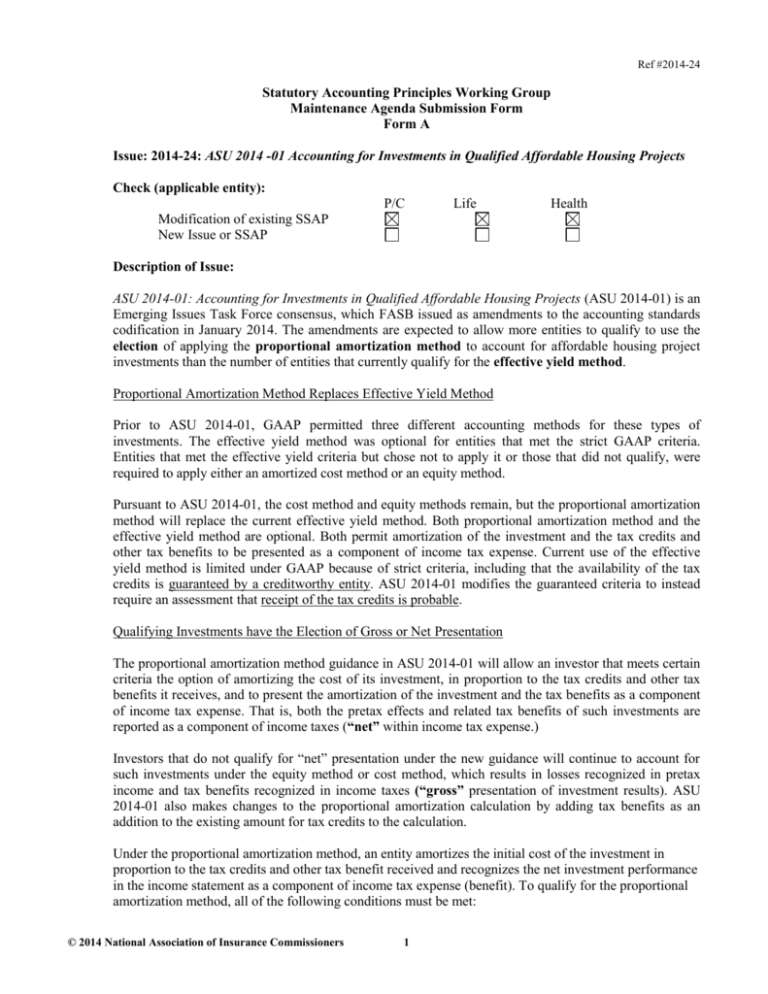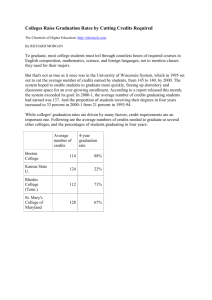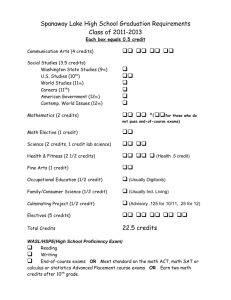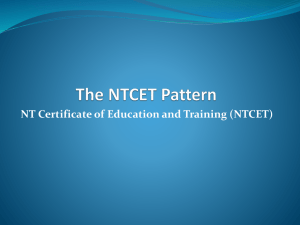Accounting for Investments in Qualified Affordable Housing Projects
advertisement

Ref #2014-24 Statutory Accounting Principles Working Group Maintenance Agenda Submission Form Form A Issue: 2014-24: ASU 2014 -01 Accounting for Investments in Qualified Affordable Housing Projects Check (applicable entity): P/C Life Health Modification of existing SSAP New Issue or SSAP Description of Issue: ASU 2014-01: Accounting for Investments in Qualified Affordable Housing Projects (ASU 2014-01) is an Emerging Issues Task Force consensus, which FASB issued as amendments to the accounting standards codification in January 2014. The amendments are expected to allow more entities to qualify to use the election of applying the proportional amortization method to account for affordable housing project investments than the number of entities that currently qualify for the effective yield method. Proportional Amortization Method Replaces Effective Yield Method Prior to ASU 2014-01, GAAP permitted three different accounting methods for these types of investments. The effective yield method was optional for entities that met the strict GAAP criteria. Entities that met the effective yield criteria but chose not to apply it or those that did not qualify, were required to apply either an amortized cost method or an equity method. Pursuant to ASU 2014-01, the cost method and equity methods remain, but the proportional amortization method will replace the current effective yield method. Both proportional amortization method and the effective yield method are optional. Both permit amortization of the investment and the tax credits and other tax benefits to be presented as a component of income tax expense. Current use of the effective yield method is limited under GAAP because of strict criteria, including that the availability of the tax credits is guaranteed by a creditworthy entity. ASU 2014-01 modifies the guaranteed criteria to instead require an assessment that receipt of the tax credits is probable. Qualifying Investments have the Election of Gross or Net Presentation The proportional amortization method guidance in ASU 2014-01 will allow an investor that meets certain criteria the option of amortizing the cost of its investment, in proportion to the tax credits and other tax benefits it receives, and to present the amortization of the investment and the tax benefits as a component of income tax expense. That is, both the pretax effects and related tax benefits of such investments are reported as a component of income taxes (“net” within income tax expense.) Investors that do not qualify for “net” presentation under the new guidance will continue to account for such investments under the equity method or cost method, which results in losses recognized in pretax income and tax benefits recognized in income taxes (“gross” presentation of investment results). ASU 2014-01 also makes changes to the proportional amortization calculation by adding tax benefits as an addition to the existing amount for tax credits to the calculation. Under the proportional amortization method, an entity amortizes the initial cost of the investment in proportion to the tax credits and other tax benefit received and recognizes the net investment performance in the income statement as a component of income tax expense (benefit). To qualify for the proportional amortization method, all of the following conditions must be met: © 2014 National Association of Insurance Commissioners 1 Ref #2014-24 1. It is probable that the tax credits allocable to the investor will be available. 2. The investor does not have the ability to exercise significant influence over the operating and financial policies of the limited liability entity. 3. Substantially all of the projected benefits are from tax credits and other tax benefits (for example, tax benefits generated from the operating losses of the investment). 4. The investor’s projected yield based solely on the cash flows from the tax credits and other tax benefits is positive. 5. The investor is a limited liability investor in the limited liability entity for both legal and tax purposes, and the investor’s liability is limited to its capital investment. A reporting entity is required to evaluate whether the conditions have been met to apply the proportional amortization method to an investment in a qualified affordable housing project through a limited liability entity at the time of initial investment on the basis of facts and circumstances that exist at that time. Reevaluation of the conditions is based on specified changes in circumstances. Effective Date and Disclosures The amendments in ASU 2014-01 are effective beginning after December 15, 2014, and interim periods within annual reporting periods beginning after December 15, 2015 with early adoption permitted. If the proportional amortization method is elected, the method is required for all eligible investments in qualified affordable housing projects. ASU 2014-01 contains impairment criteria and new disclosures to enable users of its financial statements to understand the nature of its investments in qualified affordable housing projects, and the effect of the measurement of its investments in qualified affordable housing projects and the related tax credits and other tax benefits on its financial position and results of operations. Existing Statutory Accounting Guidance Rejects the Elective of Net Presentation. The related statutory accounting guidance on affordable housing projects is in SSAP No. 93—Accounting for Low Income Housing Tax Credit Property Investments (SSAP No. 93) which adopts Emerging Issues Task Force No. 94-1: Accounting for Tax Benefits Resulting from Investments in Affordable Housing Projects (EITF 94-1) with modifications. SSAP No. 93 does not permit the optional effective yield method, which is being replaced by ASU 201401 with the optional proportional amortization method. Instead, SSAP No. 93 requires a modified amortized cost method for all (guaranteed or non-guaranteed) state and federal programs within the scope of SSAP No. 93. SSAP No. 93 adopted modifications to the GAAP amortized cost methodology. Investments in state Low Income Housing Credits Investments that do not fall within the scope of SSAP No. 93 are required to follow the equity method guidance in SSAP No. 48. The current SSAP No. 93 amortized cost method determines the amortization amount with a statutory accounting modification to include federal tax benefits during the holding period. A reporting entity investor amortizes any excess of the carrying amount of the investment over its estimated residual value during the periods in which federal tax credits are allocated to the investor. Annual amortization is based on the proportion of federal tax credits and other tax benefits received in the current year to total estimated federal tax credits to be allocated to the investor. On initial review, the amortization calculation © 2014 National Association of Insurance Commissioners 2 Ref #2014-24 is very similar to the amortization calculation ASU 2014-01 for the proportional amortization method, as it requires. (Initial Cost of Investment - Expected Residual Value) × Actual Current Tax Credits and Other Tax Benefits Total Estimated Tax Credits and Other Tax Benefits SSAP No. 93 requires a gross presentation in that income or losses under from the qualified affordable housing project and the amortization of the investment are in investment income and the tax benefits are reported in income tax expense. Existing Authoritative Literature: SSAP No. 93— Accounting for Low Income Housing Tax Credit Property Investments adopts Emerging Issues Task Force No. 94-1: Accounting for Tax Benefits Resulting from Investments in Affordable Housing Projects (EITF 94-1) with modification: 8. The modifications to EITF 94-1 are as follows: a. State Low Income Housing Tax Credit property investments, which comply with the requirements of paragraph 1 of this statement are included and will receive the accounting treatment prescribed by this statement. b. LIHTC investments (regardless of whether they are guaranteed) shall be initially recorded at cost and carried at amortized cost unless considered impaired as discussed in paragraphs 12-15 of this statement. The amortized cost method utilized shall be similar to the amortized cost method discussed in EITF 94-1 with a modification to include tax benefits during the holding period because the primary value of the LIHTC is derived during the property holding period (typically 15 years or less). An illustration has been provided in Appendix A to this statement. A reporting entity investor using the cost method shall amortize any excess of the carrying amount of the investment over its estimated residual value during the periods in which tax benefits are allocated to the investor. The estimated residual value used in determining the amount to be amortized is the estimated residual value at the end of the last period in which tax benefits are allocated to the investor and should not reflect anticipated inflation. Annual amortization should be based on the proportion of tax benefits received in the current year to total estimated tax benefits to be allocated to the investor. c. Federal tax credits shall be recognized in the income statement as an offset to federal taxes in the tax reporting year in which the tax credit is utilized in accordance with SSAP No. 101—Income Taxes, A Replacement of SSAP No. 10R and SSAP No. 10 (SSAP No. 101). State tax credits shall be recognized in the income statement as an offset to state premium tax or state income tax, whichever is applicable, in the tax reporting year in which the credit is utilized. d. Tax benefits received, other than tax credits, shall be accounted for pursuant to SSAP No. 101. Amortization shall be reported as a component of net investment income. e. AICPA Statement of Position 78-9, Accounting for Investments in Real Estate Ventures (SOP 78-9) is rejected for purposes of statutory accounting in SSAP No. 48. This statement does not intend to establish SOP 78-9 as applicable to statutory accounting. f. FASB Interpretation No. 46, Consolidation of Variable Interest Entities is (FIN 46) rejected for purposes of statutory accounting in SSAP No. 3—Accounting Changes and Corrections of Errors (SSAP No. 3). This statement does not intend to establish FIN 46 as applicable to statutory accounting. g. Many LIHTC investments require future equity contributions by the investor (equity contributions), that may be contingent on a variety of conditions, such as such as receiving representations, contract performance, meeting occupancy requirements, etc. If the commitment by the investor to provide equity contributions meets the definition of a liability as defined in SSAP No. 5R— © 2014 National Association of Insurance Commissioners 3 Ref #2014-24 h. i. j. k. Liabilities Contingencies and Impairments of Assets a liability shall be recorded. If the commitment to provide equity contributions does not meet the definition of a liability, the contingent commitment shall be disclosed in the notes to the financial statements with other contingent commitments. EITF 85-16: Leveraged Leases (EITF 85-16) is adopted for purposes of statutory accounting in SSAP No. 22—Leases (SSAP No. 22). This statement does not intend to readdress the conclusions reached in SSAP No. 22. SSAP No. 97—Investments in Subsidiary, Controlled, and Affiliated Entities, a Replacement of SSAP No. 88 (SSAP No. 97) should be utilized to account for investments that qualify as subsidiary, controlled or affiliated entities. The impairment guidance contained in this statement shall be followed. For statutory accounting purposes, deferred taxes are not reported as a component of income from continuing operations in the income statement; rather deferred taxes are recognized as a separate component of gains and losses in unassigned funds (surplus). Activity to Date (issues previously addressed by SAPWG, Emerging Accounting Issues WG, SEC, FASB, other State Departments of Insurance or other NAIC groups): Low-income housing investments are reflected as invested assets in statutory accounting and have specific lines in Annual Statement Schedule BA - Other invested Assets. In addition, there are specific categories on Schedule BA for different categories of properties for purposes of risk-based capital. Convergence with International Financial Reporting Standards (IFRS): IFRS does not contain any guidance specific to accounting for investments in qualified affordable housing projects. Information or issues (included in Description of Issue) not previously contemplated by the SAPWG: None Recommending Party: Robin Marcotte, NAIC Staff July 2014 Recommended Conclusion or Future Action on Issue: SSAP No. 93 previously rejected the concept of net presentation and optional presentation. Therefore, SSAP No. 93 does not currently permit an elective net presentation method (effective yield or proportional amortization) and does not incorporate the qualifying criteria for the elective application of a net presentation, which ASU 2014-01 updates. In addition, statutory accounting typically tries to avoid the use of optional accounting to preserve comparability. SSAP No. 93 eliminates electives by explicitly requiring a gross presentation for all state and federal programs that qualify under the law. The modified amortized cost method of gross presentation in SSAP No. 93 recognizes the amortization of the investment and any income earned in investment income and separately recognizes the tax credits and benefits as a component of income tax expense. Staff is unaware of any existing invested asset category, which is amortized directly into income tax expense and notes that doing so would be a substantive change in the treatment of amortization for invested assets. Such a change would have several ripple effects particularly for reporting entities, which are subject to AVR and IMR. While staff is aware that gross presentation makes these assets, which are primarily purchased for their tax credits, look less than profitable, it should be noted that that these investments typically generate only © 2014 National Association of Insurance Commissioners 4 Ref #2014-24 a negligible amount of income and there are existing disclosures on unexpired tax credits and amortizing an invested asset into income taxes does not provide additional transparency. The following chart summarizes the differences in presentation: Amortization of the investment cost down to residual value over the holding period Tax Credits and other tax benefits “Gross” presentation (required by SSAP No. 93 and by GAAP amortized cost method) Reported as a component of net investment income “Net” Presentation (optional for entities that qualify under ASU 2014-01) Reported as a component of income tax expense Reported as a decrease to income tax expense Reported as a decrease to income tax expense With the changes in ASU 2014-01, the GAAP asset amortization calculation moves closer to the guidance in SSAP No. 93 by including tax credits and benefits. As such, staff recommends that the Working Group move this item to the nonsubstantive active listing, and direct staff to prepare guidance to reflect the following: 1) SSAP No. 93 guidance for investment calculation should incorporate the ASU 2014-01 GAAP amortization to prevent a GAAP/SAP difference in the amount and timing of the recognition of amortization for these assets. 2) Guidance from ASU 2014-01 will be modified to require: a. Continued application of a modified amortized cost methodology for insurer reporting entities (no optionality). b. A gross presentation in the income statement. With this approach, which is consistent with current guidance in SSAP No. 93, the amortization will be reflected as a component of investment income, and the use of the tax credits and other benefits will continue to be reflected as a decrease to income tax expense. In accordance with the recommendations above, consideration would also occur as to the extent the additional GAAP disclosures could be adopted for statutory accounting, whether the illustration in SSAP No. 93 should be updated, and to propose guidance to explicitly identify the elements of ASU 2014-01 that are adopted, adopted with modification or rejected for statutory accounting. Status: On August 16, 2014, the Statutory Accounting Principles Working Group moved this item to the nonsubstantive active listing and directed NAIC staff to prepare revisions to SSAP No. 93 to continue a modified amortized cost methodology and gross presentation in investment income. Updates drafted for 2014 Fall National Meeting Discussion: This ASU revises the prior U.S. GAAP guidance, which used an optional effective yield method, with an optional proportional amortization method. The prior U.S. GAAP guidance (EITF 94-1) was adopted with modification for statutory accounting. These modifications specified that the amortized cost method detailed in SSAP No. 93 shall be similar to the amortized cost method discussed in EITF 94-1 with a modification to include tax benefits during the holding period. With the issuance of ASU 2014-01, the amortization calculation in ASU 2014-01 continues to closely resemble the statutory accounting guidance adopted in SSAP No. 93. The optional effective yield guidance in ASU 2014-01 allows a net presentation method of both the amortization of the investment and the use of tax benefits in income tax expense for partnerships that lack significant influence and meet other specified economic and legal criteria. © 2014 National Association of Insurance Commissioners 5 Ref #2014-24 Consistent with other invested assets, SSAP No. 93 requires a gross income statement presentation. With the gross presentation, income or losses under the qualified affordable housing project and the amortization of the investment are reported in investment income; the tax credits and other benefits are reported separately in income tax expense. As directed by the Working Group, proposed revisions to SSAP No. 93 are shown as tracked changes in Appendix 1 of this document. It is staff’s recommendation that the Working Group expose nonsubstantive revisions to SSAP No. 93 to adopt with modification ASU 2014-01. The modifications would prohibit the elective proportional amortization method with net reporting that is allowed in ASU 2014-01. Additional Updates proposed within the guidance include revising the phrase “limited partnership” to “limited liability entity”; adding more explicit cost amortization method guidance to make it clear how it is to be calculated; including that the cost amortization with modifications to include tax benefits is required and shall be presented gross in the financial statements; and adding disclosures not already included in SAP, along with technical edits included in the agenda item. By presenting gross, the amortization of the investment shall be included in investment income, and the tax benefits and tax credits shall be included as a component of income taxes. Other nonsubstantive changes that are of an editorial nature include updating references to transferable and non-transferable state tax credits in paragraph 2 to reflect previous revisions to SSAP No. 94R; delete paragraph 3 to reflect previous revisions to SSAP No. 48; moving the modifications to previous guidance to the Relevant Literature section; and moving relevant accounting guidance to the appropriate sections. On November 16, 2014, the Statutory Accounting Principles (E) Working Group moved this item to the nonsubstantive active listing and exposed nonsubstantive revisions to SSAP No. 93, as illustrated in Appendix 1, to adopt with modification ASU 2014-01, prohibiting the elective proportional amortization method and net reporting, and to update terminology. © 2014 National Association of Insurance Commissioners 6 Ref #2014-24 Appendix 1 Accounting for Low Income Housing Tax Credit Property Investments SSAP No. 93 Accounting for Low Income Housing Tax Credit Property Investments SCOPE OF STATEMENT 1. This statement establishes statutory accounting principles for investments in federal and certain state sponsored Low Income Housing Tax Credit (LIHTC) properties through limited liability entities that are flow-through-entities for tax purposes. State sponsored LIHTC programs that have the following characteristics are within the scope of and shall be accounted for in accordance with this statement: a. The program is based upon Internal Revenue Code (IRC) section 42. b. The investment requires an ongoing interest in a limited liability entity, which are pass through entities, and cannot be transferred apart from this interest. c. Resale value of the investment is not based upon the fair value of the underlying real estate. d. Fair value of the investment is directly tied to the remaining stream of tax credits and deductible losses available to investors. e. The critical element of value is known with a high degree of certainty before being marketed to investors. f. The modified amortized cost method is more indicative of liquidation value than the equity method. State sponsored LIHTC programs requiring ownership in a partnership or limited liability entity that do not have the foregoing characteristics shall continue to be accounted for in accordance with the requirements of SSAP No. 48—Joint Ventures, Partnerships and Limited Liability Companies (SSAP No. 48). 2. Some states have enacted laws that create programs by which transferable and non-transferable state tax credits are granted to entities under certain specified conditions (e.g., an entity makes an investment in a particular industry). Investments in transferable and non-transferable state tax credits are not within the scope of this statement. See SSAP No. 94R—Accounting for Transferable and NonTransferable State Tax Credits. SUMMARY CONCLUSION 3. LIHTC investments held by reporting entities meet the definition of an asset as specified in SSAP No. 4—Assets and Nonadmitted Assets and are admissible assets to the extent that they comply with the requirements of this statement. 4. Resale valuation of these investments is based on the present value of the future stream of tax credits and deductible losses, and not the fair value of the underlying real estate. 5. Investors in entities that manage or invest in low income housing projects receive tax benefits in the form of tax deductions from operating losses and tax credits. The tax credits are allowable on the tax return each year over a 10-year period as a result of renting a sufficient number of units to qualifying tenants and are subject to restrictions on gross rentals paid by those tenants. These credits are subject to recapture over a 15-year period starting with the first year tax credits are earned. Corporate investors © 2014 National Association of Insurance Commissioners 7 Ref #2014-24 Appendix 1 Accounting for Low Income Housing Tax Credit Property Investments SSAP No. 93 generally purchase an interest in a limited liability entity that manages or invests in the low income housing projects. [323-470-05-02 excerpt] Accounting 6. LIHTC investments shall be initially recorded at cost and carried at amortized cost unless considered impaired as discussed in paragraphs 16-19 of this statement. An illustration has been provided in Appendix A to this statement. 7. A reporting entity investor using the amortized cost method shall amortize any excess of the carrying amount of the investment over its estimated residual value during the periods in which tax benefits are allocated to the investor. The estimated residual value used in determining the amount to be amortized is the estimated residual value at the end of the last period in which tax benefits are allocated to the investor and should not reflect anticipated inflation. Annual amortization shall be based on the proportion of tax benefits received in the current year to total estimated tax benefits to be allocated to the investor. The amortization amount shall be calculated as follows: a. The initial investment balance less any expected residual value of the investment, multiplied by b. The percentage of actual tax credits and other tax benefits allocated to the reporting entity in the current period divided by the total estimated tax credits and other tax benefits expected to be received by the reporting entity over the life of the investment. 8. Under the amortized cost method, the amortization of the investment in the limited liability entity is recognized in the income statement as a component of net investment income/expense. The current tax credit (or benefit) shall be accounted for as a component of income tax expense. 9. Federal tax credits shall be recognized in the income statement as an offset to federal taxes in the tax reporting year in which the tax credit is utilized in accordance with SSAP No. 101—Income Taxes, A Replacement of SSAP No. 10R and SSAP No. 10 (SSAP No. 101). State tax credits shall be recognized in the income statement as an offset to state premium tax or state income tax, whichever is applicable, in the tax reporting year in which the credit is utilized. Tax benefits received, other than tax credits, shall be accounted for pursuant to SSAP No. 101. 10. At the time of initial investment, immediate recognition of the entire benefit of the tax credits to be received during the term of an investment in a low income housing project is not appropriate (that is, low income housing tax credits shall not be recognized in the financial statements before their inclusion in the investor’s tax return.) [323-740-25-5] 11. Many LIHTC investments require future equity contributions by the investor (equity contributions), that may be contingent on a variety of conditions, such as receiving representations, contract performance, meeting occupancy requirements, etc. If the commitment by the investor to provide equity contributions meets the definition of a liability as defined in SSAP No. 5R—Liabilities Contingencies and Impairments of Assets a liability shall be recorded. 12. If the commitment to provide equity contributions does not meet the definition of a liability, the contingent commitment shall be disclosed in the notes to the financial statements with other contingent © 2014 National Association of Insurance Commissioners 8 Ref #2014-24 Appendix 1 Accounting for Low Income Housing Tax Credit Property Investments SSAP No. 93 commitments. A liability shall also be recognized for equity contributions that are contingent on a future event when that contingent event becomes probable. 13. Additional funding that does not result in additional tax credits for the reporting entity (investor) shall be expensed as a component of net investment income. In the event a reporting entity obtains additional tax credits for a LIHTC investment, the following shall be applied: a. If additional tax credits are allocated without additional funding, the additional tax credits shall not be afforded any value; rather, the tax benefit is only recognized when realized. b. If additional funding directly related to the additional tax credits is required, the provisions of this statement shall be followed as if the additional funding were a new investment in LIHTC property. 14. An investment amortized to residual value in accordance with paragraph 7 of this statement shall not be revalued under any other method during or subsequent to the amortization period, other than as discussed in this statement. 15. Changes in estimated losses shall be accounted for in accordance with SSAP No. 3—Accounting Changes and Corrections of Errors as a change in estimate and included as a component of net investment income. Impairment 16. Reporting entities with investments in LIHTC properties shall complete and document an impairment analysis at each reporting period. If it is determined that an impairment exists, the book value of the LIHTC investment shall be compared to the present value of future tax benefits discounted at a risk free rate of return, i.e., the rate on U.S. Treasury obligations of a similar duration, and the investment shall be written-down if the book value is higher. This will result in a new cost basis and the amount of the write-down shall be accounted for as a realized loss. The new cost basis shall not be changed for subsequent recoveries in fair value. 17. Among other things, an other-than-temporary impairment (INT 06-07) shall be considered to have occurred if it is probable that future tax benefits will not be received as expected. For example, for LIHTC properties based on state tax credits, if the reporting entity intends to decrease premium volume in that state, it may affect whether or not the tax credits in that state are realizable. The best available information about market share or premiums by state and premiums by line of business generally should be used to estimate the amount of future tax credits that are realizable. For purposes of determining impairment, future tax benefits consist of both estimated tax losses and anticipated tax credits. Loan default or a reasonable probability of credit recapture would signify that tax benefits would not be received as expected. 18. In a multi-tiered partnership, whereby one limited partnership exists only to hold interests in other limited partnerships that are each invested in different developments, the impairment should be determined at the lowest tier. The partnership that holds the assets in which the impairment is determined to exist will be adjusted to a new cost basis representing the lower of book value or the present value of future tax benefits discounted at a risk free rate of interest. This new cost basis and related realized loss shall be recognized by the holder of a LIHTC investment. 19. It should be noted that a foreclosure of a single property within an LIHTC investment fund only affects the loss of tax credits on a proportional basis. For example, a foreclosure of one property in a six © 2014 National Association of Insurance Commissioners 9 Ref #2014-24 Appendix 1 Accounting for Low Income Housing Tax Credit Property Investments SSAP No. 93 property fund generating equal levels of credits would only eliminate 1/6 of the credits, thereby, only affecting 1/6 of the LIHTC investment fund value to the individual investors. Audited Financial Statements 20. The reporting entity’s return and book value of an LIHTC investment is reliant upon maintaining tax credit eligibility and not its share of the equity as reported on a financial statement. As such, a reporting entity shall monitor the tax credit eligibility of an LIHTC investment through requiring either audited GAAP or audited tax basis financial statements. In the event an audited GAAP or audited tax basis financial statement is not obtained, the asset shall be nonadmitted. Disclosures 21. Disclose the number of remaining years of unexpired tax credits and the required holding period for the LIHTC investments. 22. Disclose the amount of low-income housing tax credits and other tax benefits recognized during the years presented. 23. Disclose the balance of the investment recognized in the statement of financial position for the reporting period(s) presented. 24. Disclose if the LIHTC property is currently subject to any regulatory reviews and the status of such review. (Example investigations by the housing authority.) 25. Any commitment or contingent commitment (e.g., guarantees or commitments to provide additional capital contributions) including the amount of equity contributions that are contingent commitments related to LIHTC properties investments and the year(s) that contingent commitments are expected to be paid shall be disclosed. 26. The significance of an investment to the reporting entity's financial position and results of operations shall be considered in evaluating the extent of disclosures of the financial position and results of operations of an investment in a LIHTC. If in the aggregate the LIHTC investments exceed 10% of the total admitted assets of the reporting entity the following disclosures shall be made: a. (1) The name of each partnership or limited liability entity and percentage of ownership, (2) the accounting policies of the reporting entity with respect to investments in partnerships and limited liability entities (3) the difference, if any, between the amount at which the investment is carried and the amount of underlying equity in net assets (i.e., nonadmitted goodwill or other nonadmitted assets) and (4) the accounting treatment of the difference; b. For partnerships, and limited liability entities for which a quoted fair value is available, the aggregate value of each partnership, or limited liability entity investment based on the quoted fair value; and c. Summarized information as to assets, liabilities, and results of operations for partnerships, and limited liability entities either individually or in groups. 27. A reporting entity that recognizes an impairment loss shall disclose the following in the financial statements that include the period of the impairment write-down: © 2014 National Association of Insurance Commissioners 10 Ref #2014-24 Appendix 1 Accounting for Low Income Housing Tax Credit Property Investments SSAP No. 93 a. A description of the impaired assets and the facts and circumstances leading to the impairment; and b. The amount of the impairment and how fair value was determined. 28. Disclose the amount and nature of the write-downs or reclassifications made during the year resulting from the forfeiture or ineligibility of tax credits, etc. These write-downs may be based on actual property level foreclosure, loss of qualification due to occupancy levels, compliance issues with tax code provisions within an LIHTC investment or other issues. 29. Refer to the preamble for further discussion regarding disclosure requirements. Relevant Literature 30. This statement adopts with modification ASU 2014-01—Investments—Equity Method and Joint Ventures (Topic 323): Accounting for Investments in Qualified Affordable Housing Projects. The modifications include: a. ASU 2014-01 allows the election of using the proportional amortization method if an affordable housing project investment meets several critieria including the lack of significant influence. This statement does not allow the proportional amortization method (previously called effective yield method) by all reporting entities. b. The proportional amortization election in ASU 2014-01 utilizes a net presentation in the financial statements by including the amortized initial cost of the investment and the tax credits and benefits received within income tax expense. This statement requires a gross presentation on the financial statements, with amortization of the initial cost of the investment in investment income and the tax credits and benefits included in income tax expense. c. Paragraphs 323-740-50-2c and 323-740-50-2d related to disclosures of the optionality of method used and net reporting, are rejected as not applicable to statutory accounting. d. Disclosures should be followed as indicated in the disclosures section in this Statement. 31. This statement adopts with modification EITF 94-1: Accounting for Tax Benefits from Investments in Affordable Housing Projects as applicable to Statutory Accounting to the extent it is not modified by ASU 2014-01. In 2006, this statement modified Issue Paper No. 99 to remove the reference to EITF 94-1. 32. ASU 2014-01 and EITF 94-1 are modified for the following statutory concepts: a. The elective effective yield method and the net income statement reporting in EITF 94-1 are not permitted. The elective proportional amortization method in ASU 2014-01, which replaced the effective yield method and the net income statement reporting, is also not permitted for statutory accounting. b. Investments that meet the criteria of this statement are required to use a cost amortization method as prescribed in this statement. This method requires the tax credits and benefits to be recognized in proportion to the percentage of actual tax credits and other tax benefits allocated to the reporting entity in the current period divided by the total © 2014 National Association of Insurance Commissioners 11 Ref #2014-24 Appendix 1 Accounting for Low Income Housing Tax Credit Property Investments SSAP No. 93 estimated tax credits and other tax benefits expected to be received by the reporting entity over the life of the investment. This statement requires a gross presentation on the financial statements, with amortization in investment income. c. Federal tax credits shall be recognized in the income statement as an offset to federal taxes in the tax reporting year in which the tax credit is utilized in accordance with SSAP No. 101—Income Taxes, A Replacement of SSAP No. 10R and SSAP No. 10 (SSAP No. 101). State tax credits shall be recognized in the income statement as an offset to state premium tax or state income tax, whichever is applicable, in the tax reporting year in which the credit is utilized. d. Tax benefits received, other than tax credits, shall be accounted for pursuant to SSAP No. 101. Amortization shall be reported as a component of net investment income. e. Many LIHTC investments require future equity contributions by the investor (equity contributions), that may be contingent on a variety of conditions, such as receiving representations, contract performance, meeting occupancy requirements, etc. If the commitment by the investor to provide equity contributions meets the definition of a liability as defined in SSAP No. 5R—Liabilities Contingencies and Impairments of Assets a liability shall be recorded. If the commitment to provide equity contributions does not meet the definition of a liability, the contingent commitment shall be disclosed in the notes to the financial statements with other contingent commitments. f. SSAP No. 97—Investments in Subsidiary, Controlled, and Affiliated Entities, a Replacement of SSAP No. 88 (SSAP No. 97) should be utilized to account for investments that qualify as subsidiary, controlled or affiliated entities. g. The impairment guidance contained in this statement shall be followed. h. For statutory accounting purposes, deferred taxes are not reported as a component of income from continuing operations in the income statement; rather deferred taxes are recognized as a separate component of gains and losses in unassigned funds (surplus). 33. AICPA Statement of Position 78-9, Accounting for Investments in Real Estate Ventures (SOP 789) is rejected for purposes of statutory accounting in SSAP No. 48. This statement does not intend to establish SOP 78-9 as applicable to statutory accounting. 34. FASB Interpretation No. 46, Consolidation of Variable Interest Entities (FIN 46) is rejected for purposes of statutory accounting in SSAP No. 3. This statement does not intend to establish FIN 46 as applicable to statutory accounting. 35. EITF 85-16: Leveraged Leases (EITF 85-16) is adopted for purposes of statutory accounting in SSAP No. 22. This statement does not intend to readdress the conclusions reached in SSAP No. 22. Effective Date and Transition 36. This statement is effective for reporting periods beginning on or after January 1, 2006. Early adoption is permitted. A change resulting from the adoption of this statement shall be accounted for as a change in accounting principle in accordance with SSAP No. 3. The guidance previously in paragraph 3 of this SSAP superseded paragraph 1 of SSAP No. 48. In 2011, this guidance was moved to SSAP No. 48—Joint Ventures, Partnerships and Limited Liability Companies and deleted from this SSAP. The © 2014 National Association of Insurance Commissioners 12 Ref #2014-24 Appendix 1 Accounting for Low Income Housing Tax Credit Property Investments SSAP No. 93 original guidance included in this standard is retained for historical purposes in Issue Paper No. 125. The guidance in paragraphs 6-12, 22 and 23 from ASU 2014-01 is effective for reporting periods beginning on or after January 1, 2015, with early adoption permitted. REFERENCES Relevant Issue Papers Issue Paper No. 125—Accounting for Low Income Housing Tax Credit Property Investments © 2014 National Association of Insurance Commissioners 13 Ref #2014-24 Appendix 1 Accounting for Low Income Housing Tax Credit Property Investments SSAP No. 93 APPENDIX A – LOW INCOME HOUSING TAX CREDIT PROPERTY INVESTMENTS A Limited Partnership Investment in an Affordable Housing Project Accounted for Using the Amortized Cost Method (modified to include tax benefits and record amortization as a component of net investment income): This appendix is based on ASU 2014-01, paragraph 323-740-55-7 of the Accounting Standards Codification. The GAAP proportional amortization method is not permitted because of optionality, the criteria required for the methodology is narrower than SAP and the methodology allows net reporting. The amount and timing of amortization in the proportional amortization method is consistent with the statutory modifications to the cost amortization, therefore, the table incorporated in this appendix is based on the proportional amortization table. Terms: Date of Investment: January 1, 20X1 Purchase Price of Investment: $100,000 Assumptions: 1. All cash flows (except initial investment) occur at the end of each year. 2. Depreciation expense is computed, for book and tax purposes, using the straight-line method with a 27.5 year life (the same method is used for simplicity). 3. The investor made a $100,000 investment for a 5 percent limited partnership interest in the project at the beginning of the first year of eligibility for the tax credit. 4. The partnership finances the project cost of $4,000,000 with 50 percent equity and 50 percent debt. 5. The annual tax credit allocation (equal to 4 percent of the project's original cost) will be received for a period of 10 years. 6. The investor's tax rate is 40 percent. 7. For simplicity, the project will operate with break-even pretax cash flows including debt service during the first 15 years of operations. 8. The project's taxable loss will be equal to depreciation expense. The cumulative book loss (and thus the cumulative depreciation expense) recognized by the investor is limited to the $100,000 investment. 9. It is assumed that all requirements are met to retain allocable tax credits so there will be no recapture of tax credits. 10. The investor expects that the estimated residual value of the investment will be zero. © 2014 National Association of Insurance Commissioners 14 Ref #2014-24 Appendix 1 Accounting for Low Income Housing Tax Credit Property Investments Drafting Note: This table will be deleted. © 2014 National Association of Insurance Commissioners 15 SSAP No. 93 Ref #2014-24 Appendix 1 Accounting for Low Income Housing Tax Credit Property Investments SSAP No. 93 Drafting Note: This table will be added. Cost amortization with statutory modifications table Year 1 2 3 4 5 6 7 8 9 10 11 12 13 14 15 Total Net Investment (1) 100000 90909 81818 72727 63636 54545 45454 36363 27272 18181 9090 6666 4242 1818 0 0 Amortization of Investment (2) Tax Credits (3) Net Losses/Tax Depreciation (4) Other Tax Benefits from Tax Depreciation (5) Tax Credits and Other Tax Benefits (6) 9091 9091 9091 9091 9091 9091 9091 9091 9091 9091 2424 2424 2424 1818 8000 8000 8000 8000 8000 8000 8000 8000 8000 8000 7273 7273 7273 7273 7273 7273 7273 7273 7273 7273 7273 7273 7273 5451 2909 2909 2909 2909 2909 2909 2909 2909 2909 2909 2909 2909 2909 2183 10909 10909 10909 10909 10909 10909 10909 10909 10909 10909 2909 2909 2909 2183 0 100000 80000 100000 40000 120000 1. End-of-year investment for a 5 percent limited liability interest in the project net of amortization in column 2. 2. Initial investment of $100,000 x (total tax benefits received during the year in Column (6) / total anticipated tax benefits over the life of the investment of $120,000). 3. Four percent tax credit on $200,000 tax basis of the underlying assets. 4. Depreciation (on $200,000 tax basis of the underlying assets) using the straight-line method over 27.5 years up to the amount of the initial investment of $100,000. 5. Column (4) × 40% tax rate. 6. Column (3) + column (5) 7. Column (6) - column (2) g:\data\stat acctg\3. national meetings\a. national meeting materials\2014\fall\nm exposures\14-24 asu 2014-01 11-16-14.docx © 2014 National Association of Insurance Commissioners 16







